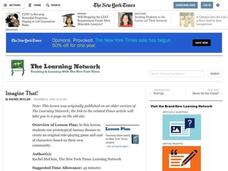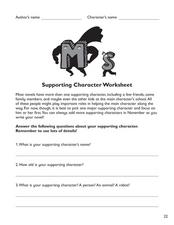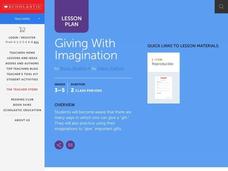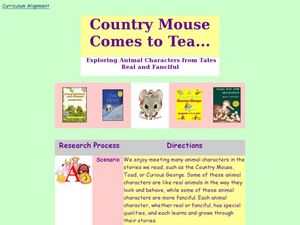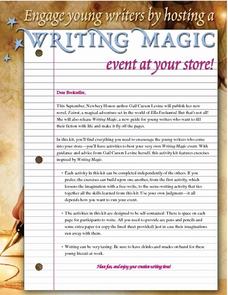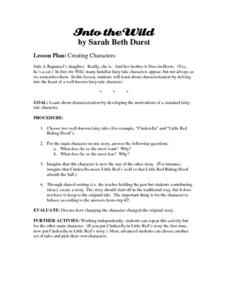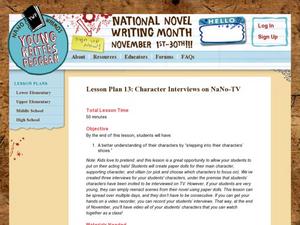Facebook
Pop Imagination
Popular culture can pack a powerful punch when it comes to creating awareness around an issue! Teams collaborate to create a pop-culture-themed message during a digital citizenship instructional activity. Part of a vast library of...
Curated OER
Imagine That!
Enter the fantastical world of "Dungeons and Dragons" and other role-playing games with this lesson from The New York Times. Middle schoolers create the outline for a role-playing game based on their own community. Then, they...
Curated OER
Make Up Your Story
Putting together an interesting story can be hard, but this set of worksheets will guide your writers into the depths of their own creativity as they characterize both their main character and villain. Using humor to keep learners...
Curated OER
Supporting Character Worksheet
Where would Harry Potter be without Ron Weasley? Where would Holmes be without Watson? Where would a good narrative be without an interesting supporting character? Encourage character analysis with this resource, which includes six...
Curated OER
Chatty Cherry Stories
Young artists will respond to reading children's literature, by engaging in original storytelling and representing their own images through the visual arts. Then they orally describe details of people, places, and things in their stories...
Curated OER
Giving with Imagination
Demonstrate gift giving as an act of caring about someone versus gifts for show (or gifts from the purse). Elementary learners practice giving gifts from the heart by creating a poem for someone special to them.
Curated OER
Country Mouse Comes to Tea: Exploring Animal Characters from Tales Real and Fanciful
Students study animal characters. In this language arts lesson, students analyze animal characters from a variety of books and create a story using animal characters.
Curated OER
Imaginative Power - Exploring Superheroes
Third graders identify super human powers and their uses found in comic and cartoon characters, identify use of visual elements such as line, shape, and color, and create drawings of an original super character with at least two extra...
Curated OER
Lesson Plan 7: The Elements of Story
Budding novelists work on character development by relating to the characters in their stories. They imagine their own hopes and dreams and recall those of characters from books they've read. Learners also consider struggles the...
Curated OER
Flat Stanley Visits....Your Imagination in Claymation!
In this literature lesson, students read the Jeff Brown book Flat Stanley and collaborate to create claymation characters from the story. Students create a claymation video and discuss using word cards during hte movie.
Curated OER
Drama from Animal Characters
Learn about animal habitats, characteristics, and writing in a different perspective. The class composes a narrative from the perspective of a fresh water animal, they include a problem and the animal's reaction to the problem. The...
Curated OER
Flight of the Imagination
Students study the success of video games by reading an online article. They work in groups to design settings, storylines, characters and technical features for their own fantasy video games. Finally, they write scripts for previews of...
Curated OER
What a Character! Comparing Literary Adaptations
What do Robert Downey Jr., Basil Rathbone, Jeremy Brett, Fritz Weaver, Roger Moore, Benedict Cumberbatch, and Daffy Duck have in common? Why, it’s elementary, my dear Watson! They all have portrayed Sherlock Holmes. Literary detectives...
Curated OER
Analyzing Poetry and Characters
Students investigate historical context by reading poetry. In this language arts instructional activity, students discover the work of Michael Longley and examine his poem "Ceasefire." Students identify the sonnets used in...
Curated OER
Writing Magic
Learners write a story. In this writing lesson plan, students are given a series of prompts to promote them in writing a story. The prompts include writing a free write, writing about characters, writing about a setting, writing about...
Curated OER
Into the Wild: Creating Characters
Students analyze well-known fairy tale characters to learn about characterization. After choosing two fairy tale characters and determining what the characters most want and most fear, students switch characters and stories. They...
Curated OER
Our Computers, Ourselves: Imagining the Digital Lives of Authors and Characters
The guiding question for this lesson plan is "Do computers and their contents shape who we are?" Open with a selection of Apple's commercials to introduce stereotypes and people's relationships with their computers. Then, read the...
Curated OER
Lesson Plan 13: Character Interviews on NaNoTV
Kids love to pretend. Use this imaginative energy to develop their understanding of characterization. Class members dress up as a character from their novel-writing project and sit for a filmed interview. In responding to questions about...
Curated OER
Write Some Dialogue
Students write dialogue. For this character development activity students use direct or indirect speech to include a confrontation between two characters in their story. Students portray the emotions of the characters in addition to what...
Curated OER
The "Write" Stuff: Strategies and Conventions for Imaginative Writing
Fifth graders develop and practice the steps involved in imaginative writing. They follow the steps/worksheets included and write imaginative stories of their own.
Curated OER
Searching for Stars
Positive character traits in literature are explored in this character development and literacy lesson. Learners listen to Cinderella by Charles Perrault and Little Gold Star by Robert D. San Souci, followed by a discussion comparing the...
Curated OER
We Like to Imagine - Animals
Students describe a pretend animal. They read "The After School Monster." Students read other books and discuss whether or not the characters are real. Students make a drawing of a pretend animal and of a real animal. They make up a...
Curated OER
Imagination
Students participate in a computer game which helps them develop their hand-eye coordination and imagination. They can use this activity before doing writing activities or show and tell.
Curated OER
Pride and Prejudice: Unsent Letter
What would the characters of Pride and Prejudice say to each other in a letter? Draft unsent correspondence between characters from Jane Austen's novel. A great way to explore characterization and plot structure in a creative lesson.



